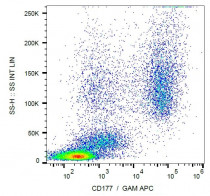ARG62748
anti-CD177 antibody [MEM-166]
anti-CD177 antibody [MEM-166] for CyTOF®-candidate,Flow cytometry,Immunoprecipitation,Western blot and Human,Primates
Immune System antibody
Overview
| Product Description | Mouse Monoclonal antibody [MEM-166] recognizes CD177 |
|---|---|
| Tested Reactivity | Hu, NHuPrm |
| Tested Application | CyTOF®-candidate, FACS, IP, WB |
| Specificity | The clone MEM-166 reacts with CD177 (Neutrophil specific antigen 1), a 60 kDa GPI-linked cell surface glycoprotein of uPAR family, expressed on granulocytes and in bone marrow early erythroblasts, megakaryocytes, promyelocytes and myelocytes. HLDA VI; WS Code M M17 HLDA VI; WS Code BP 309 |
| Host | Mouse |
| Clonality | Monoclonal |
| Clone | MEM-166 |
| Isotype | IgG1 |
| Target Name | CD177 |
| Antigen Species | Human |
| Immunogen | Human granulocytes |
| Conjugation | Un-conjugated |
| Alternate Names | NB1 glycoprotein; PRV-1; PRV1; NB1; CD177 antigen; Human neutrophil alloantigen 2a; NB1 GP; HNA2A; Polycythemia rubra vera protein 1; CD antigen CD177; HNA-2a |
Application Instructions
| Application Suggestion |
|
||||||||||
|---|---|---|---|---|---|---|---|---|---|---|---|
| Application Note | WB: Under non-reducing condition. * The dilutions indicate recommended starting dilutions and the optimal dilutions or concentrations should be determined by the scientist. |
Properties
| Form | Liquid |
|---|---|
| Purification | Purified from ascites by protein-A affinity chromatography. |
| Purity | > 95% (by SDS-PAGE) |
| Buffer | PBS (pH 7.4) and 15 mM Sodium azide |
| Preservative | 15 mM Sodium azide |
| Concentration | 1 mg/ml |
| Storage Instruction | For continuous use, store undiluted antibody at 2-8°C for up to a week. For long-term storage, aliquot and store at -20°C or below. Storage in frost free freezers is not recommended. Avoid repeated freeze/thaw cycles. Suggest spin the vial prior to opening. The antibody solution should be gently mixed before use. |
| Note | For laboratory research only, not for drug, diagnostic or other use. |
Bioinformation
| Database Links | |
|---|---|
| Gene Symbol | CD177 |
| Gene Full Name | CD177 molecule |
| Background | CD177 (NB1/HNA-2a and PRV-1 form) is a GPI-anchored glycoprotein present mainly on neutrophils. Its plasma membrane expression is increased during pregnancy and and inflammation or after G-CSF application. Ligand of CD177 has been identified as CD31 (PECAM-1). CD177 participates in neutrophil transmigration and seems to be also a pro-proliferative molecule. The antibodies against CD177 can be involved in neonatal alloimmune neutropenia (NAN). |
| Highlight | Related products: CD177 antibodies; Anti-Mouse IgG secondary antibodies; Related news: CyTOF-candidate Antibodies |
| Research Area | Immune System antibody |
| Calculated MW | 46 kDa |
| PTM | N-glycosylated. A soluble form may also be produced by proteolytic cleavage at the cell surface (shedding). |
Images (1) Click the Picture to Zoom In
Clone References








